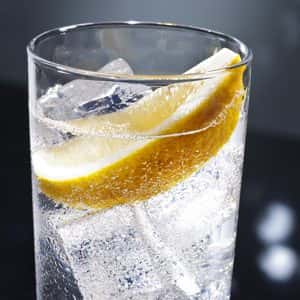
Quinine is bitter. Once you have tasted it you will not forget the taste of quinine. It gives tonic water a distinctive flavor. People who love gin and tonic savor the unique bite of this drink, especially if you throw in a lime or lemon wedge. Quinine also has medicinal properties. Just a few decades ago, you could buy quinine pills over the counter in most pharmacies under brand names like Legatrin, Quinamm and Q-vel.
The FDA banned the use of OTC quinine to treat leg cramps in 1994. Although this drug has been available for centuries, the FDA determined that it was far too dangerous to use for anything but malaria. See this link for more information on the ban. In its infinite wisdom, however, the Food and Drug Administration did not ban quinine from tonic water.
Quinine Dangers:
The trouble is that some people are extremely sensitive to quinine’s toxic effects. This drug can cause headache, rash, ringing in the ears, nausea, dizziness and blurred vision.
Deadly Reactions:
The most serious reactions are rare but can be deadly (StatPearls, Aug. 3, 2021). In some cases, quinine disrupts the rhythm of the heart.
In addition, it can trigger blood disorders that can lead to hemorrhage. A review a few years ago turned up 142 patients with acute immune-mediated reactions (American Journal of Hematology, May 2016). They experienced chills, fever, dangerously low blood pressure and a range of very serious vascular problems. Ninety percent of them had to be hospitalized for severe illness. While almost three-fourths had taken quinine pills, about 20 percent had consumed quinine-containing beverages. Three of these patients died.
It’s important for people who sense they may be vulnerable to quinine to avoid it in both pills and tonic water. Here are some symptoms that could be a tipoff to trouble.
High-tone Hearing Loss:
According to a report in the British Journal of Clinical Pharmacology (June 1990):
“Quinine reduced high tone auditory acuity in all patients, resulting in flattening of the audiograms. The effect was rapid in onset, usually unnoticed (although tinnitus was reported in seven patients), and resolved completely after treatment was completed.”
Gastrointestinal Symptoms:
The symptoms that someone is experiencing quinine toxicity include loss of appetite, nausea, vomiting, abdominal discomfort and/or diarrhea.
Other Symptoms:
Anyone who experiences dark urine, bleeding gums, a nasty headache, nosebleeds, chills, signs of jaundice (yellowing of the skin and/or eyes), breathing problems, chills or fever should contact a physician immediately or go to an emergency department.
Quinine Reactions Can Be Deadly:
Another report covered a case series of 19 patients who reacted badly to quinine (American Journal of Kidney Diseases, Nov. 2017). One person died before treatment; 17 required renal dialysis. Despite this treatment, 8 of these people died. A serious quinine reaction can be deadly.
We also worry about pregnant people taking quinine. Although they appear to suffer leg or muscle cramps more often, quinine could disrupt the development of the fetus (BMJ Clinical Evidence, May 13, 2015).
FDA Banned Quinine:
With that context, it’s easier to understand why the FDA ordered drug companies to stop selling quinine for anything but malaria in 2007. Only one product was allowed. Qualaquin could be prescribed by physicians, but the cost is high for such an old drug. Thirty Qualaquin pills could cost over $200. That could make sense for a drug to treat malaria, which is rare in the US. Generic quinine runs between $30 to $60 for 30 pills.
Any physician who prescribes Qualaquin for leg cramps could risk the wrath of the FDA.
On July 8, 2010, the agency issued the following warning.
“The U.S. Food and Drug Administration today warned that the unapproved use of the malaria drug Qualaquin (quinine sulfate) to treat night time leg cramps has resulted in serious side effects and prompted the manufacturer to develop a risk management plan aimed at educating health care professionals and patients about the potential risks.
“Qualaquin is not FDA-approved to treat or prevent night time leg cramps.
“A review of reports submitted to the FDA’s Adverse Event Reporting System (AERS) between April 2005 and Oct. 1, 2008, found 38 U.S. cases of serious side effects associated with the use of quinine, the active drug in Qualaquin.
“Quinine use resulted in serious and life-threatening reactions in 24 cases, including low level of platelets in the blood (thrombocytopenia), and hemolytic uremic syndrome/thrombotic thrombocytopenic purpura, a blood disorder that results in clots in small blood vessels around the body that can be accompanied by kidney impairment.
“In some patients, these side effects resulted in permanent kidney impairment and hospitalization. Two patients died. Most of those reporting serious side effects took the drug to prevent or treat leg cramps or restless leg syndrome.”
What About Tonic Water?
Clearly, quinine can be dangerous for some individuals, but the FDA has not banned quinine from tonic water. To do so would make the FDA a laughing stock. It would also aggravate millions of people who like gin and tonic…or just plain tonic. It is an acquired taste, but some people really like it. It’s also possible that the FDA doesn’t consider tonic water a danger to public health.
Because of this loophole, many people have discovered that drinking tonic water might help prevent muscle cramps.
One reader related her experience:
“I suffered with nightly leg cramps until one magic day on the Greek island Santorini. I had gone on tour as a guest singer of the New York Choral Society. One free afternoon, a group of us went to a black sand beach where I swam. The only other member of the group who also swam was a New York trauma surgeon. I developed a cramp and was trying to walk it out when he told me about Schweppes tonic, which contains a very small amount of quinine.
“I couldn’t find any tonic on Santorini or in Athens, but as soon as I returned home I started drinking a large glass (diet, with cranberry) every night. It has worked for me for several years, but I definitely know if I skip a dose!
“I asked a pharmacist friend to search the literature to see if anything else contains a small amount of quinine. She couldn’t find anything and told me the dangers of using high-dose quinine. I have checked with my doctors and have heard nothing against my practice of drinking Schweppes.”
Tonic contains 83 mg. of quinine in a liter. An eight-ounce glass of tonic would only have about 20 mg of quinine, considerably less than the dose that used to be prescribed by doctors for leg cramps (200 to 300 mg).
Does Tonic Water Work for Muscle Cramps?
Despite the low dose, however, many readers maintain that it works:
“My doctor recommended tonic water for nocturnal leg cramps. It works every time very quickly. In less than five minutes I get relief and can go back to sleep. I suffer NO pains if I drink half a glass before I go to bed.”
Carmel in New York reports:
“I had horrible cramps in my legs. I have been drinking several glasses of tonic water for the past 3 or 4 weeks and surprisingly the cramping has subsided. At least now I can sleep the night. It’s not too bad tasting with lime.”
Mariza in Los Angeles shares this experience:
“I too used to have such intense legs cramps leaving me writhing in pain. They could occur daily, day or night. I couldn’t even flex my leg muscles. I learned to deal with it by drinking a glass of tonic water, but only after the pain had already started.”
Even Tonic Water Has Some Hazards:
Some people find even the small amount of quinine in tonic water can pose problems. These folks may experience ringing in the ears, rash, itching or blurred vision and should steer clear of tonic water altogether.
There are those who are so sensitive that even a little bit of quinine could prove life threatening.
“Quinine in tonic water proved almost fatal for me. Nighttime leg cramps have been an ongoing problem, so I bought a bottle of tonic water.
“On Saturday I had a 5-ounce glass before supper. Sunday morning by 9 am I was in the emergency room with a frightening skin reaction. I was hospitalized for many days and diagnosed with a dangerous blood disorder called idiopathic thrombocytopenic purpura (ITP). My hematologist said it was triggered by the quinine water.”
We have also heard from people who developed tinnitus after drinking tonic:
“I have just developed a hissing sound in my ears. The onset was very rapid! The doctor diagnosed it as tinnitus, but would give me no reason for the problem. He said there wasn’t anything I could do. I’ve noticed some days it is less disturbing than others but some nights it awakens me because it has become so loud.
“I was drinking large quantities of tonic water, which contains quinine, when this started. Do you have any suggestions to help me?”
The quinine in tonic water is the likely culprit. Ringing or hissing in the ears can be a complication of quinine. Stop drinking tonic water altogether if you detect tinnitus.
What About Buying Quinine from Canada?
Over the last two decades we have heard from many people who are upset that they can no longer buy quinine. Many say that this drug is the only thing that works for leg cramps. One reader reported that there wasn’t enough quinine in tonic water to do the job. He discovered that he could buy quinine from Canadian pharmacies. Here is a link to that article with some additional insights on the pros and cons of quinine.
What Else Can You Do for Leg Cramps?
For people who cannot tolerate or stand the taste of tonic water, there are alternatives. The FDA has approved no medications for easing leg cramps. That means most doctors have very little to offer patients in pain.
Judy in Issaquah, Washington, did get some intriguing advice from her doctor:
TRP Channels and Leg Cramps:
We were fascinated to read that a physician would recommend soap under the bottom sheet to prevent leg cramps. Most health professionals scoff at this home remedy. We have received numerous comments that this must be a placebo effect. That’s because these people have not considered a possible mechanism. We have explained how soap might work to prevent leg cramps in this article.
Thanks to a Nobel prize winner (Rod MacKinnon, MD) and his neurobiologist colleague Bruce Bean, PhD, we now have an explanation for how things like a spoonful of mustard could make muscle cramps go away within a couple of minutes.
It all has to do with stimulating sensory nerves in the mouth, throat and stomach. The science of transient receptor potential (TRP) channels that explains how these remedies work has only been developed over the last couple of decades. However, it probably explains why mustard, quinine and pickle juice are so effective at relieving muscle cramps promptly.
Learn More:
If you would like to learn a lot more about how to get relief from nocturnal leg cramps, our Guide to Leg Pain has instructions on stretching as well as a range of remedies. You will also find lots of suggestions in our 264-page book from National Geographic, The People’s Pharmacy Quick & Handy Home Remedies.
Share your own solutions to leg cramps and your experience with tonic water in the comment section below.
Citations
- Euwema MS & Swanson TJ, "Deadly single dose agents." StatPearls, Aug. 3, 2021.
- Liles NW et al, "Diversity and severity of adverse reactions to quinine: A systematic review." American Journal of Hematology, May 2016. DOI: 10.1002/ajh.24314
- Page EE et al, "Quinine-induced thrombotic microangiopathy: A report of 19 patients." American Journal of Kidney Diseases, Nov. 2017. DOI: 10.1053/j.ajkd.2017.05.023
- Young G, "Leg cramps." BMJ Clinical Evidence, May 13, 2015.


